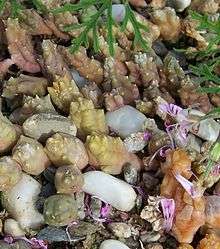Huernia
The genus Huernia (family Apocynaceae, subfamily Asclepiadoideae)[2] consists of perennial, stem succulents from Eastern and Southern Africa and Arabia, first described as a genus in 1810.[3][4]
| Huernia | |
|---|---|
 | |
| Huernia macrocarpa var. penzigii | |
| Scientific classification | |
| Kingdom: | Plantae |
| Clade: | Tracheophytes |
| Clade: | Angiosperms |
| Clade: | Eudicots |
| Clade: | Asterids |
| Order: | Gentianales |
| Family: | Apocynaceae |
| Subfamily: | Asclepiadoideae |
| Tribe: | Ceropegieae |
| Genus: | Huernia R.Br. |
| Type species | |
| Huernia campanulata (Masson) R.Br. ex Haw.[1] | |
The flowers are five-lobed, usually somewhat more funnel- or bell-shaped than in the closely related genus Stapelia, and often striped vividly in contrasting colors or tones, some glossy, others matte and wrinkled depending on the species concerned. Frequently the flowers are colored a variation of red, yellow or brown.[5] To pollinate, the flowers attract flies by emitting a scent similar to that of carrion. The genus is considered close to the genera Stapelia and Hoodia. Phylogenetic studies have shown the genus to be monophyletic, and most closely related to the genus Tavaresia, and to a widespread branch of stapeliads comprising the genera Orbea, Piaranthus and Stapelia.[6]
The name of the plant is in honor of Justus van Heurne (1587–1653?) a Dutch missionary, botanist, and doctor, who is reputed to have been the first European to document and collect South African Cape plants.[3][5][7] His surname has variations (van Horne, Heurnius, van Heurnius),[7] however it was misspelled by the plant collector.[5]
Various species of Huernia are considered famine food by the inhabitants of Konso special woreda in southern Ethiopia. The local inhabitants, who call the native species of this genus baqibaqa indiscriminately, eat it with prepared balls of sorghum (kurkufa); they note that baqibaqa tastes relatively good and has no unpleasant side-effects when boiled and consumed.[8] As a result, local farmers encouraged it to grow on stone walls forming the terraces, where it does not compete with other crops.[8]
Species
Sixty four species of Huernia are found in Africa (East Africa, South Africa and Ethiopia) and Arabia (Saudi Arabia, Yemen).[5][9]
- Huernia andreaeana - Kenya
- Huernia barbata - South Africa
- Huernia campanulata
- Huernia clavigera - South Africa
- Huernia confusa - Transvaal
- Huernia decemdentata - Cape Province
- Huernia distincta - Cape Province
- Huernia guttata
- Huernia hallii - Namibia
- Huernia humilis - South Africa
- Huernia insigniflora - Transvaal
- Huernia kennedyana - South Africa
- Huernia kirkii - Cape Province
- Huernia levyi - Zimbabwe
- Huernia loeseneriana - South Africa
- Huernia longii - Cape Province
- Huernia longituba - Cape Province
- Huernia lopanthera - Angola
- Huernia macrocarpa (Huernia penzigii)
- Huernia mccoyi - Yemen
- Huernia namaquensis - Little Namaqualand
- Huernia nouhuysii - Transvaal
- Huernia ocellata
- Huernia oculata - South Africa
- Huernia pendula - Cape Province
- Huernia piersii - Cape Province
- Huernia pillansii - South Africa
- Huernia plowesii - Namibia
- Huernia praestans - Cape Province
- Huernia primulina - South Africa
- Huernia procumbens - Transvaal
- Huernia quinta - South Africa
- Huernia reticulata - South Africa
- Huernia schneideriana - Southeastern Africa
- Huernia similis - Angola
- Huernia simplex - South Africa
- Huernia stapelioides - South Africa
- Huernia tanganyikensis - Tanzania
- Huernia thudichumii - Cape Province
- Huernia thureti - South Africa
- Huernia transvaalensis - Transvaal
- Huernia tubata - South Africa
- Huernia urceolata - Angola, Namibia
- Huernia venusta
- Huernia volkartii - Angola
- Huernia whitesloaneana - Transvaal
- Huernia witzenbergensis - Cape Province
- Huernia zebrina - Cape Province
- formerly included[9]
moved to Angolluma
- Huernia sprengeri now Angolluma sprengeri
 Huernia asperia
Huernia asperia- Huernia piersii
.jpg) Huernia primulina
Huernia primulina- Huernia quinta
- Huernia striata
 Huernia guttata
Huernia guttata Huernia zebrina
Huernia zebrina
References
- lectotype designated by White et Sloane, Stapelieae ed. 2. 3: 819. 1937
- Chaney, Cathryn. "Planting Guides for Lifesaver Cactuses". SFGate.com. Hearst. Retrieved 2019-08-13.
- Brown, Robert. 1810. On the Asclepiadeae 11
- "Name - Huernia R. Br". www.tropicos.org. Retrieved 2019-08-14.
- "Asclepiadaceae: Huernia". succulent-plant.com. Retrieved 2019-08-13.
Justus van Heurne
- P. Bruyns, C. Klak, P. Hanacek: Evolution of the stapeliads (Apocynaceae-Asclepiadoideae) - repeated major radiation across Africa in an Old World group. Molecular Phylogenetics and Evolution. 2014. v. 77, no. 1, p. 251--263. ISSN 1055-7903.
- Gunn, Mary; Codd, L. E. W. (1981). Botanical Exploration Southern Africa, Introductory volume to the Flora of Southern Africa. CRC Press. p. 187. ISBN 9780869611296 – via Google Books.
- Guinand, Yves; Lemessa, Dechassa (10 March 2000). "Wild-food Plants in Southern Ethiopia: Reflections on the role of 'famine-foods' at a time of drought - Ethiopia". ReliefWeb. UNDP Emergencies Unit for Ethiopia. Retrieved 2019-08-14.
- The Plant List genus Huernia